This page is shown in Figure 1 and shows all the information relating to the selected  budget item.
budget item.
 edit or
edit or  delete the budget item, or add an
delete the budget item, or add an  expense item,
expense item,  attachment or
attachment or  comment to this budget item.
Some details of the budget item are displayed just below the top header area in subsections, such as the item’s location within Psoda, it’s description, as well as any workflow information where you may be permitted to
comment to this budget item.
Some details of the budget item are displayed just below the top header area in subsections, such as the item’s location within Psoda, it’s description, as well as any workflow information where you may be permitted to  request or
request or  authorise a state transition. The rest of the page is made up of a number of tabs or sections (depending on your selected view):
authorise a state transition. The rest of the page is made up of a number of tabs or sections (depending on your selected view):
This tab shows an asset listing of all of the attachments that have been added to this budget item, as shown in Figure 2. By default, this table will present you with a number of details about the attachments such as the file’s name, attachment type, view the version and access a download link.
From the Actions column of this attachments table, you can act on individual attachments by  editing,
editing,  deleting,
deleting,  moving or
moving or  locking/
locking/ unlocking the selected attachment.
unlocking the selected attachment.

 edit button at the bottom of the attachment table or navigate to this same spot to
edit button at the bottom of the attachment table or navigate to this same spot to  add more attachments to this budget item. Here, you can also export this budget list to
add more attachments to this budget item. Here, you can also export this budget list to  Excel or
Excel or  CSV files.
At the very bottom of this tabbed view, you have the option to add more attachments by utilising the drag and drop functionality to drag the files you wish to upload into the drop box (note that this function works in HTML5 compliant browsers only).
CSV files.
At the very bottom of this tabbed view, you have the option to add more attachments by utilising the drag and drop functionality to drag the files you wish to upload into the drop box (note that this function works in HTML5 compliant browsers only).
Instead of a table view, this tab provides a graphical view of your accumulated baseline vs. actual over time for this budget item. Figure 3 below shows an example chart:
This tab shows an asset listing of all of the comments that  users have made on this budget item, as shown in Figure 4. By default, this table will present you with a number of details about the comments such as, the date that this comment was last updated, who created the comment, the comment itself and any associated tags to name a few.
From the Actions column of this comments table, you can act on individual comments by
users have made on this budget item, as shown in Figure 4. By default, this table will present you with a number of details about the comments such as, the date that this comment was last updated, who created the comment, the comment itself and any associated tags to name a few.
From the Actions column of this comments table, you can act on individual comments by  editing or
editing or  deleting the selected comment.
deleting the selected comment.

 edit button at the bottom of the comment table or navigate to this same spot to
edit button at the bottom of the comment table or navigate to this same spot to  add more comments to this budget item. Here, you can also export this comment list to
add more comments to this budget item. Here, you can also export this comment list to  Excel or
Excel or  CSV files.
CSV files.
This tab shows some additional details about that baselined costs for each month on this budget item, as shown in Figure 5.

This tabbed view shows the expenses table shown in Figure 6, containing any expenses that have been logged for the budget item. By default, this table shows the reference, description, date, date of payment as well amount including and excluding tax information. The number of comments and attachments added to an expense item is also indicated in this view.
The Actions column of the expenses table provides accessible functions to act on a chosen expense item. These functions include  editing,
editing,  deleting,
deleting,  moving or
moving or  copying the chosen expense item or adding a
copying the chosen expense item or adding a  comment or
comment or  attachment to that expense item.
attachment to that expense item.
This tab shows shows some basic history of the budget item, as shown in Figure 7. By default, this tab will present you with a number of details about the budget item’s history such as the creation date, creation user, last update date and last update user. If the budget item has been changed then this section will also show a table of all the changes that has been made, including the date of each change, the field changed, the value before the change and the user who made the change.
Figure 1 – Budget item view page
The top header area allows you to Attachments
Attachments
This tab shows an asset listing of all of the attachments that have been added to this budget item, as shown in Figure 2. By default, this table will present you with a number of details about the attachments such as the file’s name, attachment type, view the version and access a download link.
From the Actions column of this attachments table, you can act on individual attachments by 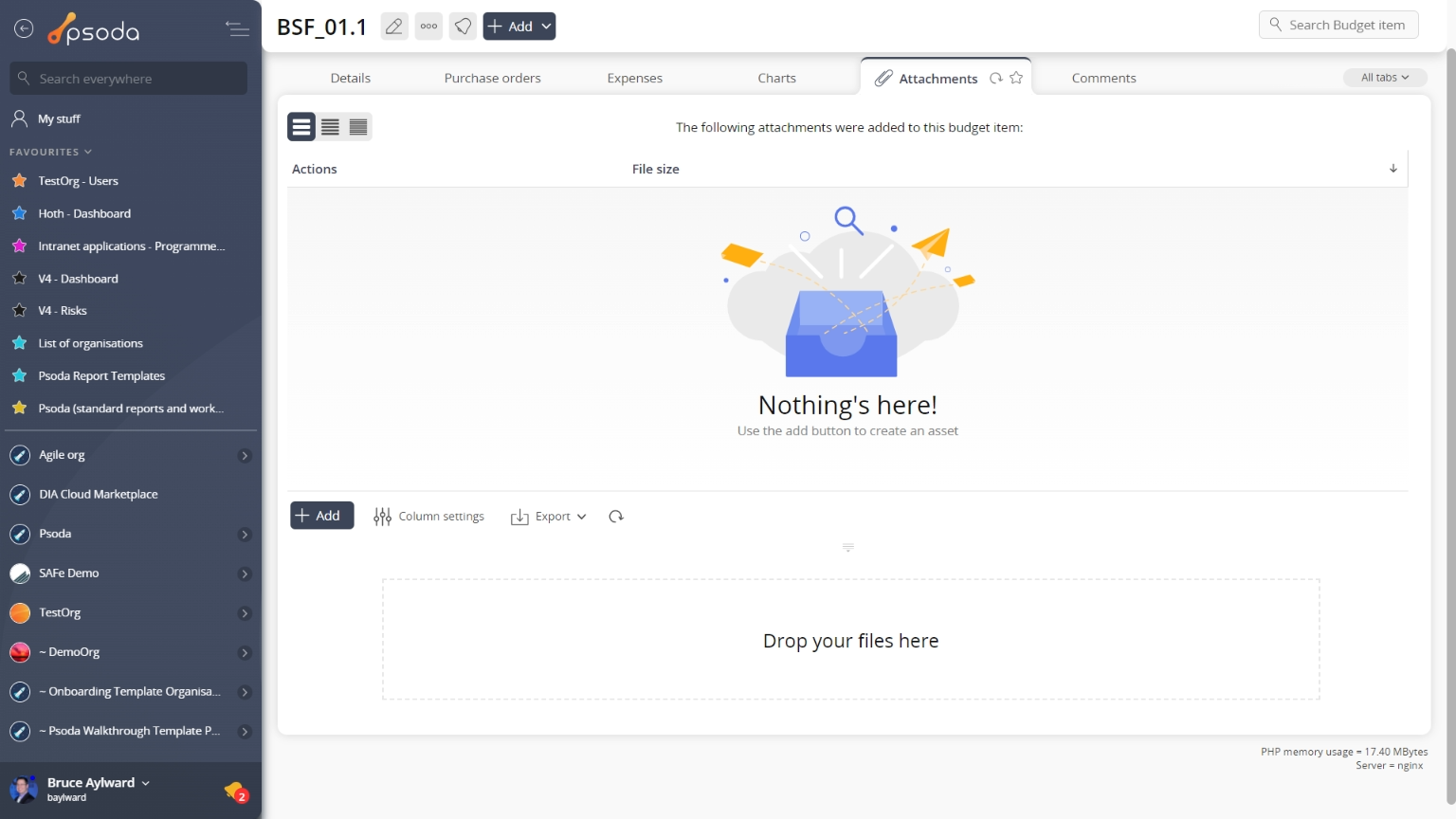
Figure 2 – Budget item attachments tab
Note that you can customise your table view by clicking the Charts
Charts
Instead of a table view, this tab provides a graphical view of your accumulated baseline vs. actual over time for this budget item. Figure 3 below shows an example chart: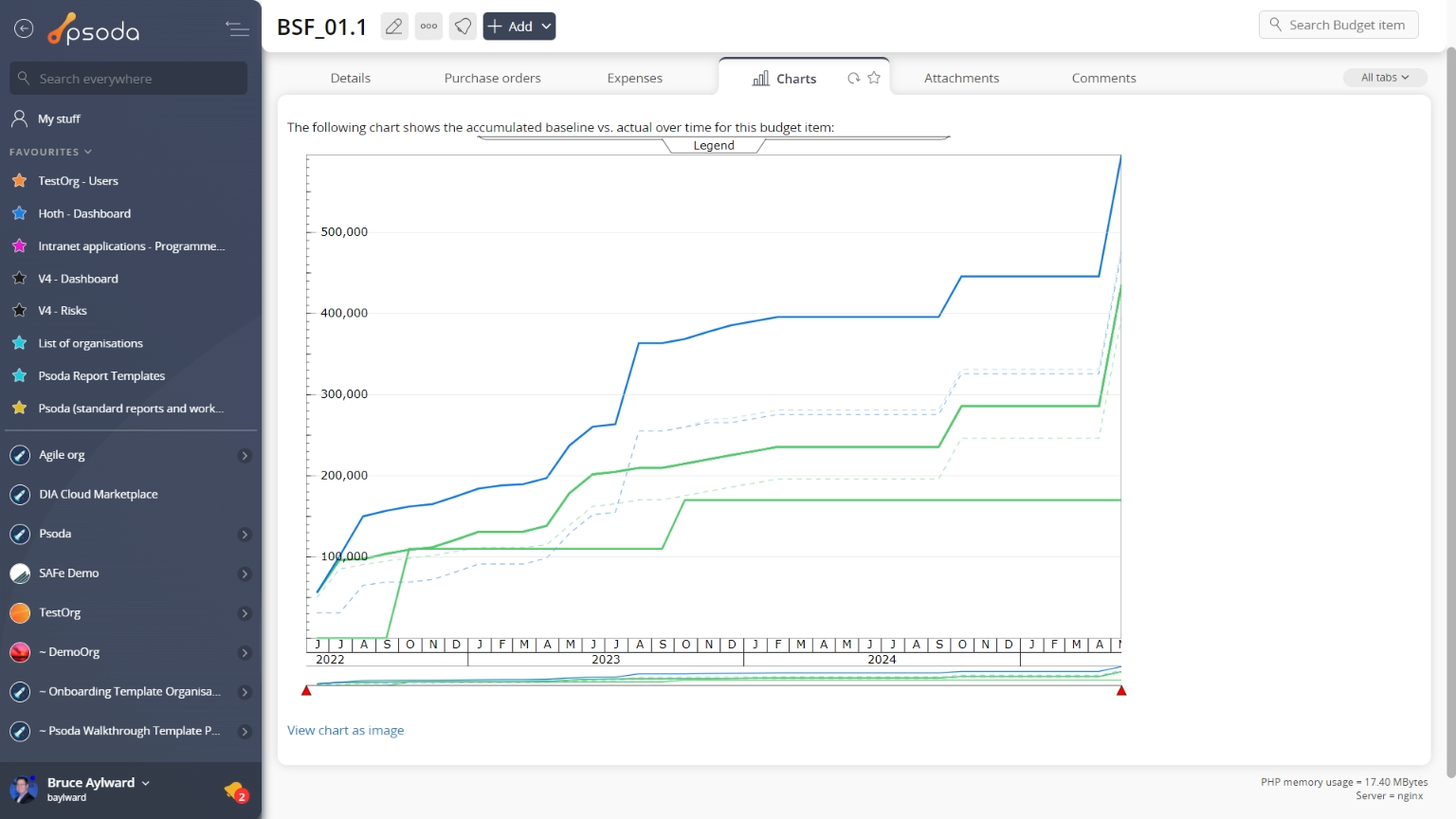
Figure 3 – Budget item chart tab
Zoom in or out on certain times by using the red arrows at the bottom of the chart. Comments
Comments
This tab shows an asset listing of all of the comments that 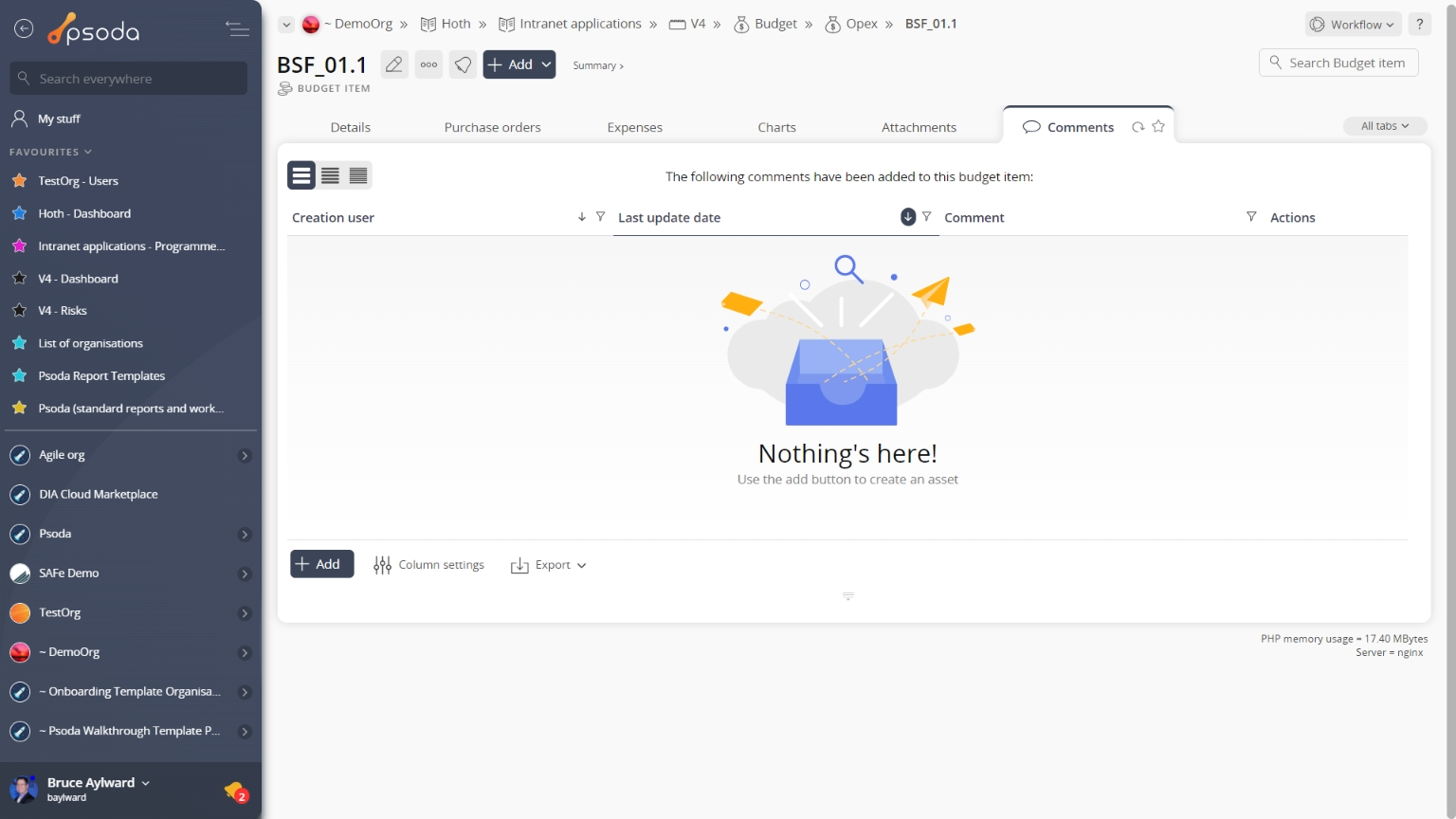
Figure 4 – Budget item comments tab
Note that you can customise your table view by clicking the Details
Details
This tab shows some additional details about that baselined costs for each month on this budget item, as shown in Figure 5.
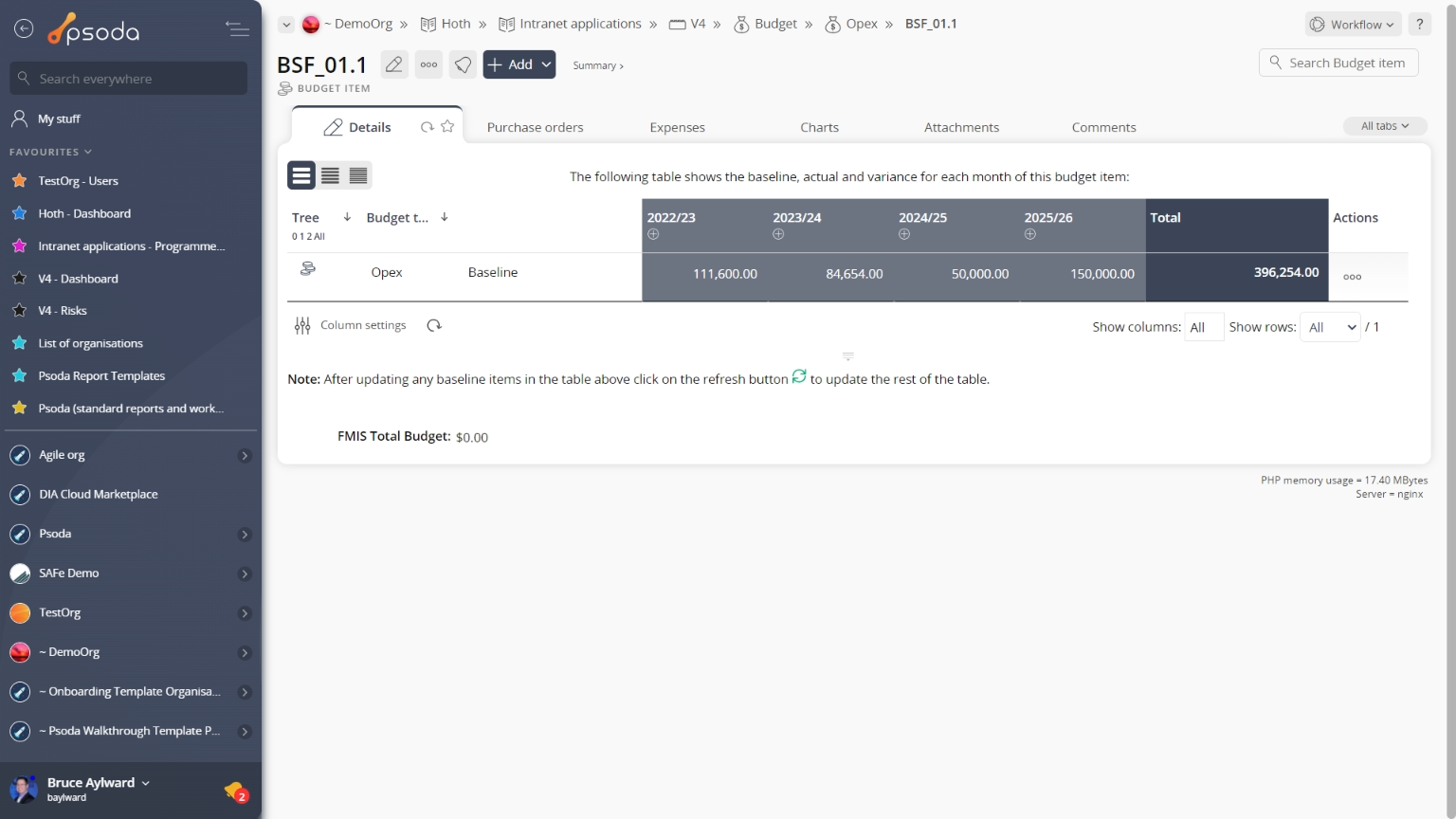
Figure 5 – Budget item details tab
If you have JavaScript enabled then the baselined costs can be edited by clicking on the number, using inline editing. Make any changes require and press tab or enter or use the mouse to click outside of the field. If you press escape the field will be restored to its original value. This same mechanism is available in all the tables that contain budget items. Expenses
Expenses
This tabbed view shows the expenses table shown in Figure 6, containing any expenses that have been logged for the budget item. By default, this table shows the reference, description, date, date of payment as well amount including and excluding tax information. The number of comments and attachments added to an expense item is also indicated in this view.
The Actions column of the expenses table provides accessible functions to act on a chosen expense item. These functions include Note that you can customise your table view by clicking the edit button at the bottom of the expenses table. Here, you can also export this list to
Excel or
CSV files.
 History
History
This tab shows shows some basic history of the budget item, as shown in Figure 7. By default, this tab will present you with a number of details about the budget item’s history such as the creation date, creation user, last update date and last update user. If the budget item has been changed then this section will also show a table of all the changes that has been made, including the date of each change, the field changed, the value before the change and the user who made the change.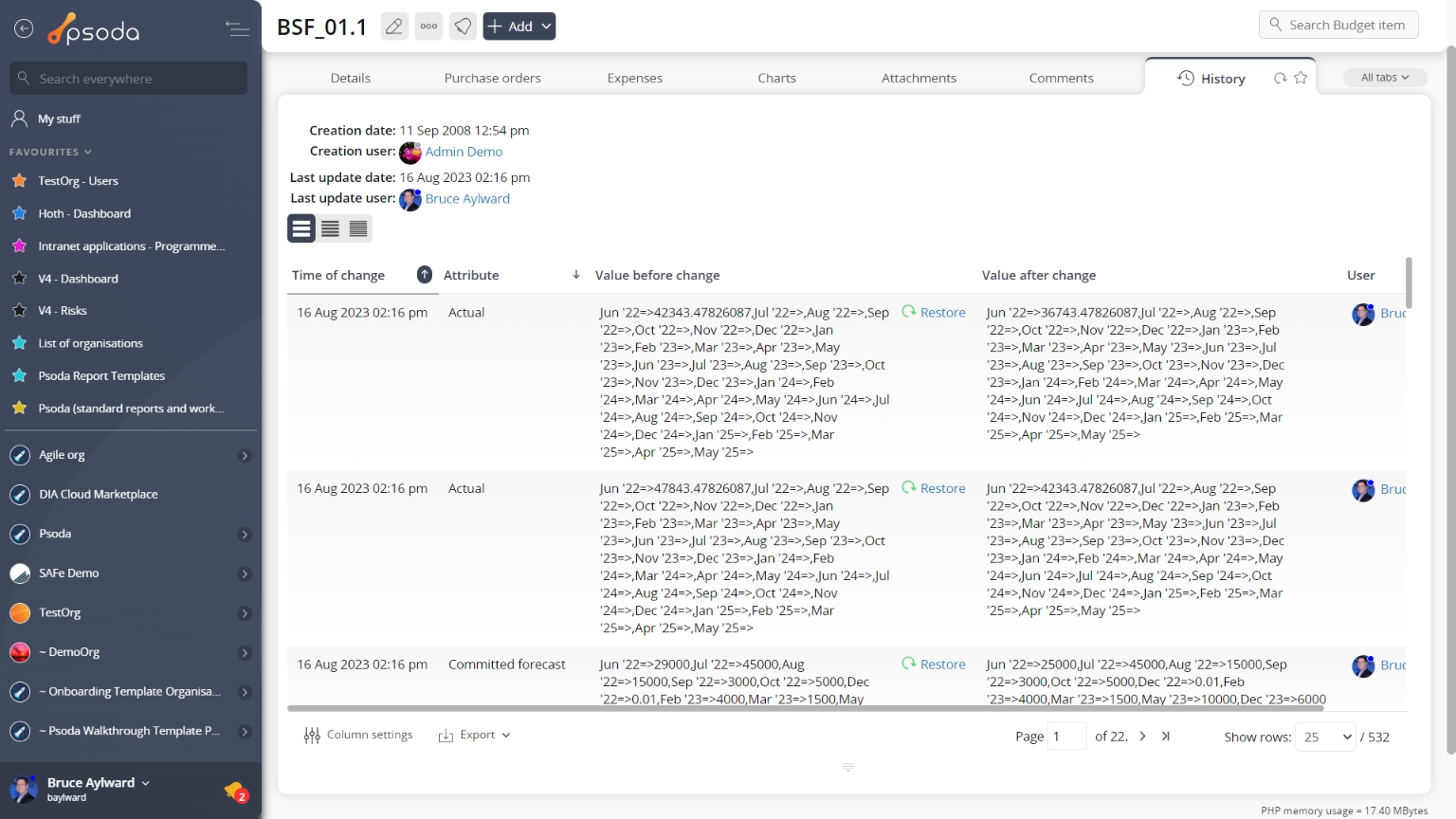
Figure 7 – Budget item history tab
Note that you can customise your change table view by clicking the edit button at the bottom of the change table. Here, you can also export this list of changes to
Excel or
CSV files.
